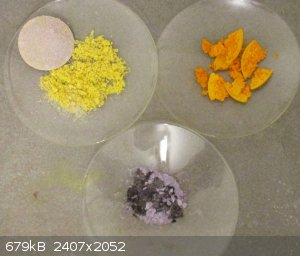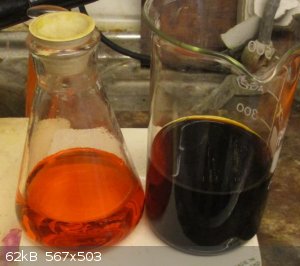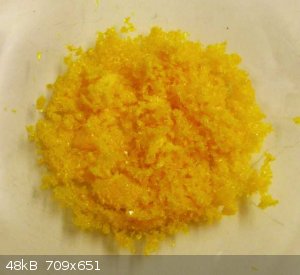Boffis
International Hazard
    
Posts: 1836
Registered: 1-5-2011
Member Is Offline
Mood: No Mood
|
|
Potassium Hexacyanochromate III
I wanted to experiment with this compound under various conditions that I will probably describe later but first I needed to prepare the starting
material. Having obtained some impure potassium cyanide I decided to try simply reacting it with somewhat less than the stoichiometric amount of
chromium III chloride in aqueous solution. Hmmmm... What a mess. The only reference to the preparation of this compound on SM is a brief post and link
by Hegli unfortunately the link is no longer active but he mentions that the yield was only 10%.
An initial greenish grey ppt formed (probably chromium hydroxide or a basic salt) that on prolonged and gentle warming largely dissolved to given a
deep brown solution which when evaporated down on a steam bath in a shallow basin and then filtering hot gave a dark brown crystalline product that
under the microscope is clearly a mixture of materials, pale coloured prisms, a brown solid and a soluble brown material. Repeated crystallisation of
this mixture without excess heating (max 70 C, boiling increases the amount of insoluble material) gave a small amount of pale yellowish needles and a
deep purple, insoluble solid. Losses to the solutions were considerable but I am working on these to see if I can recover something.
Then I decided to try an alternative process via chromium perchlorate on the basis that perchlorate ions are only very weakly complexing with Cr3+ and
so I will only have to displace the coordinated water. I reduced some potassium dichromate with sodium metabisulphite in dilute sulphuric acid in the
cold and then made the green solution strongly alkaline with sodium hydroxide. A grey green precipitate formed and was allowed to settle for a week.
The ppt was washed by decanting once and allowed to settle again for a couple of days. The supernatent liquid was poured off easily to leave most of
the chromium hydroxide at the bottom of the beaker. A carefully calculated quantity of 60% (9.2M) perchloric acid was added to the residue and warmed
gently until most had dissolved. The suspension was filtered and the deep green chromum III perchlorate solution diluted with an equal volume of
water. This solution was added to a 20% excess of aqueous potassium cyanide. The initial precipitate dissolves fairly quickly at first and the
solution become deep brown and finally orange-brown but with much precipitate. After about 3 hours of warming at about 60-70 C the solution was left
to stand overnight, filtered to remove the brownish purple precipitate (mostly potassium perchlorate) and then evaporated down slowly on a steam bath
with a strong forced draft. Slowly more brown precipitate formed. When a crystalline film began to form a little water was added and the solution
reheated to 70 C, filtered hot and cooled. An abundant pale yellow crystalline prcipitate formed that was filtered off and dried at about 35 C. After
a few days it had dried but darked to a brown colour.
The filtrate was evaporated down again as before and filtered again to remove the freshly formed purple precipitate to give a deep orange-red solution
which slowly formed a deep yellow mass of crystals. After 24 hours these were filtered off and sucked as dry as possible and washed with a little
ethanol. The product is very soluble in water. The crystals are obviously a mixture of two compounds, one pale yellow needles and the other beautiful
deep orange rhombic tables.
I evaporated down the filtrate further and recovered a second crop of less well formed orange crystals, the crystals were filtered off but seemed
difficult to such dry and alcohol seems to form a viscous orange oil that is difficult to suck out so the damp cake was pressed between filter papers.
It is currently drying and the small amount of very alkaline red liquor was discarded.
I think that the deep purple ppt is the chromium analog of prussian blue except that the chromium is all Cr3+. The recrystallised brownish cake from
the first experiment has now give a pale yellow needly solid which I think is crude potassium hexacyanochromate.
The pale yellow crystals from the second preparation fit the description for fairly pure K hexacyanochromate III but the orange crystals from the
filtrate of this preparation are a mystery. I wonder if they could be something like a pentacyanoaquochromate III or similar. I am going to try and
prepare more to see if this material is a general product of this reaction.
I will provide a detailed write-up when I have finished all of my experiments and analysed the results but Hegli's 10% yield doesn't look unrealistic.
|
|
|
Lion850
National Hazard
   
Posts: 514
Registered: 7-10-2019
Location: Australia
Member Is Offline
Mood: Great
|
|
Have a look at
https://www.youtube.com/watch?v=zqo1VL1eW4o
and see if it is helpful (I did not look myself).
I like Poormanschemist channel.
|
|
|
Boffis
International Hazard
    
Posts: 1836
Registered: 1-5-2011
Member Is Offline
Mood: No Mood
|
|
Thanks Lion850, I watched the video but I am not sure that this technique will work with chromium but I might give it a try.
The hexacyanochromate ion seems to be a little bit less stable than the corresponding iron III compound and may lose some of its cyanide and
disproportionate to chromium hexacyanochromate which is what I believe the dark purple stuff is. I have no idea what the orange crystals are.
|
|
|
unionised
International Hazard
    
Posts: 5103
Registered: 1-11-2003
Location: UK
Member Is Offline
Mood: No Mood
|
|
Exchange of ligands on Cr(III) is notoriously slow.
Is it worth considering reduction to Cr(II) then forming a cyanato complex and then oxidising it to Cr(III)?
|
|
|
Boffis
International Hazard
    
Posts: 1836
Registered: 1-5-2011
Member Is Offline
Mood: No Mood
|
|
@ unionised, thanks for that idea. Looking into it this may be the way to go. I'll have a go at this.
|
|
|
unionised
International Hazard
    
Posts: 5103
Registered: 1-11-2003
Location: UK
Member Is Offline
Mood: No Mood
|
|
The one problem I foresee is that the pH might be a impossible
Cr(II) isn't very stable at the best of times, and I think that adding alkali will make it worse.
Cyanide isn't good in acid conditions.
|
|
|
Boffis
International Hazard
    
Posts: 1836
Registered: 1-5-2011
Member Is Offline
Mood: No Mood
|
|
I thought I would post this photo of my attempt to prepare potassium hexacyanochromate described above.

The lemon yellow crystals are the crude K hexacyanochromate, the deeper yellow (top right) crystals are a mixture of normal hexacyanochromate and an
orange, beautifully crystalline compound and the lilac coloured material is the precipitate that forms when the solution stands or is overheated (the
darker material is still damp, it dries paler), this material I think is chromium III hexacyanochromate.
|
|
|
Boffis
International Hazard
    
Posts: 1836
Registered: 1-5-2011
Member Is Offline
Mood: No Mood
|
|
@unionised; you're a star  ! !
I decided to try a route via chromium II sulphate. I dissolved 5g of lab grade chromium powder in 6.5ml of 85% sulphuric acid and 25ml of water,
displaced the air with propane (the only "inert" gas available) and gently heated until dissolved; about 4 hour. I then added this solution to a
solution of KCN (6Meq) containing an extra 5ml of 50% potassium hydroxide solution. A very dark coloured suspension formed as before but after 2 hour
warming at 70 C with constant stirring the ppt was green and the solution much paler. When I filtered the solution the result was amazing. The
photograph below contrasts this experiment (orange solution on the left) with a similar batch prepared from chromium III acetate (dark brown
solution).
An interesting feature of this reaction is a small amount of odourless gas is evolved that appears to be hydrogen!
This method looks much more promising. The only problem is that the crystals that form first appear to be potassium sulphate but evaporation of the
solution on the water bath does not seem to cause the same amount of decomposition as with the CrIII route product.
I have tracked down a whole series of papers on chromium cyanocomplex and they are clearly not very stable and tend to loose CN- which is then
replaced by OH- or H2O producing aquocyanochromium or hydroxycyano complexes right down to cyanopentaaquochromium 2+ cations.

[Edited on 13-4-2020 by Boffis]
|
|
|
unionised
International Hazard
    
Posts: 5103
Registered: 1-11-2003
Location: UK
Member Is Offline
Mood: No Mood
|
|
Cr(II) is a pretty strong reducing agent. In alkaline conditions it's quite capable of reducing water to hydrogen, so I'm not particularly surprised
to see it.
It's nice to see chromium living up to its name with lots of pretty colours.
|
|
|
Boffis
International Hazard
    
Posts: 1836
Registered: 1-5-2011
Member Is Offline
Mood: No Mood
|
|
Success? At least it looks a lot better than the previous batches. I have yet to test it but at least its the right colour.
This is my attempt at potassium hexacyanochromate from Chromium II sulphate:

I have a further crop of crystals forming at present so this is not the whole yield but it looks reasonably good and it is much more stable than the
product prepared from CrIII salts. The loss of Cr is to a deep green ppt which is rather inert. I presume that it is a hydrated Cr2O3.
By contrast when a CrIII salt is used a large amount of dark purple to almost black ppt forms that is not attached by 50% KOH solution so does not
appear to be a complex cyanide nor does it appear to be a simple oxide.
|
|
|